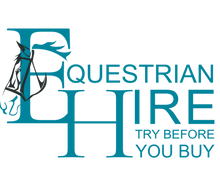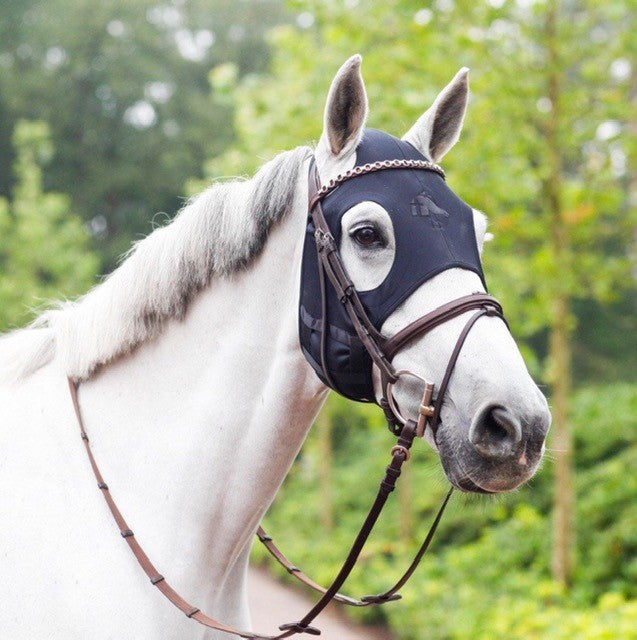Why I’m Writing This
I’ve been selling (and hiring) the Fenwick Liquid Titanium mask for 4+ years. Thanks to my home‑trial USP, I’ve collected a lot of practical feedback across disciplines and situations. I also see the market shifting: copycat products are appearing, and a large equestrian supplier is poised to flood the market with cheaper look‑alikes. My goal is to help you see the facts clearly — what works, why it works, and occasionally it doesn’t
What Makes Fenwick Different?
1) The Fabric (this is the big one)
Fenwick’s Liquid Titanium® is a patent‑protected technical fabric. The technology is woven into the textile, not just a surface finish. That’s why you’ll see a consistent effect when used correctly. With many copies, the visual design is similar, but the textile science isn’t the same, so results aren’t the same.
Key takeaway: With calming masks, fabric > look. If the textile isn’t the real deal, the effect won’t be either.
2) Fit & Pattern
Fenwick refined its pattern specifically for comfort and coverage & including options with sound reducing ears. Fit matters. A well‑fitted mask stays secure without over‑tightening and allows the horse to eat, drink and is comfortable to wear.
3) A Track Record You Can Check
Fenwick Equestrian (USA) has been producing this mask for a few years and has published information and references on how and why the fabric is used. Do your due diligence: read the research section on their site and check for patent notices and disclaimers. Reputable brands are clear about IP.
Race Hoods vs Calming Masks (Common Confusion)
- Race hoods/ear plugs are primarily used for sound damping. They’re not designed to calm; they manage auditory stimuli. You can’t race in an ear bonnet (it would fly off), so hoods with padded ears are used instead.
- Fenwick LT masks are designed for a calming/relaxation effect via the Liquid Titanium fabric. Different purpose; different mechanism.
Real‑World Results from Our Home Trials
- Over hundreds of hires, < 10% are returned within the two‑week period. That means ~90% of riders choose to keep the mask because they feel it helps their horse or pony.
- Where do people see benefits? Common themes in customer feedback:
- Pre‑ride focus (less fidgeting while tacking up)
- Traveling (loading and in‑transit relaxation)
- Busy environments (warm‑up arenas, show days)
- Routine yard stress (new horses, box rest, field changes)
Honesty note: It doesn’t help every horse. Expect roughly 1 in 10 to show little/no change. That’s normal with any management tool.
How to Use the Mask Correctly (to Maximise Your Chances)
The key is the 45 minute rule, you need to put it on for a minimum of 45 minutes before you need it to work. For horses on box rest then it will take around 20 - 30 minutes before it becomes effective.
Copies & Look‑Alikes: A Buyer’s Checklist
Use this quick audit before you buy:
- Fabric authenticity: Does the brand explicitly give a credible, specific fabric technology? Can they document it with research?
- Patent/IP clarity: Are there patent numbers or notices? Vague claims like “titanium‑infused” with no detail are a red flag.
- Evidence you can verify: Is there a research/FAQ page that actually answers how it works? Any disclaimers you should read?
- Sizing & pattern: Are there clear size charts, multiple ear options, and fitting guidance?
- After‑sales support: Can you hire/trial it? What’s the returns rate or satisfaction data?
- Reviews that ring true: Look for platform reviews (e.g., Trustpilot) with specific scenarios, not just generic praise.
Important: A cheaper price can be tempting, but the cost of a tool that doesn’t work is more than its price tag. It costs you time, frustration, and lost training days — and may lead you to conclude that no mask works, which isn’t fair to a tool that does when it’s the genuine article.
When It Might Not Help (Set Realistic Expectations)
- Primary pain or clinical issues: If behaviour stems from pain (teeth, ulcers, saddle fit, lameness), address that first with your vet/therapist.
- Inconsistent use: Results depend on correct timing of use.
FAQs
Is it allowed in competition?
Rules vary by discipline and level and can change. Always check your current rulebook or ask your governing body/steward before competing. At time of writing, they are legal to use BS Showjumping & FEI Jumping, British Eventing in showjumping phase & same FEI Eventing but not in British Dressage or FEI Dressage.
Can my horse wear it under a bridle?
Yes
How do I choose size & ear options?
There is a size guide on my website, the important measurement it from between the ears to raised cheekbone down the front of the face. You can always double check with me.
How do I clean it?
Follow Fenwick’s care instructions — typically a not more than 30 degrees or hand wash with non bio detergent. Air‑dry, and avoid harsh chemicals to protect fabric. They do hand wash very well.
How quickly will I notice a change?
Some owners notice a difference on first use; others see a trend over several sessions as part of a routine.
Try Before You Buy (2‑Week Home Trial)
I built my business around try‑before‑you‑buy because I want owners to make evidence‑based decisions in their environment. If it helps, keep it. If it doesn’t, send it back — no hard feelings as long as it isn’t damaged! Our real‑world data (about 90% keep rate) tells its own story.
Next step: Start a two‑week trial today or message me for fit/usage guidance. Have a look at some of my Trustpilot reviews.
Ethos: Horse Welfare First
I’m a rider and advocator of social licence so welfare comes before sales. Tools like the Fenwick LT mask are non‑pharmaceutical options that can sit alongside good management. Where they help, they’re invaluable. Where they don’t, we say so.
Final Word
Cheaper look‑alikes will come and go. Fabric science and fit — plus real‑world outcomes — are what matter. If you want to know whether the Fenwick LT mask will help your horse, the safest path is simple: Hire it, give it a fair trial, and make up your own mind. If it helps, brilliant. If it doesn’t, £28 isn’t a lot for genuine peace of mind.
By Susannah Equestrian Hire — reseller & hire specialist since 2012

